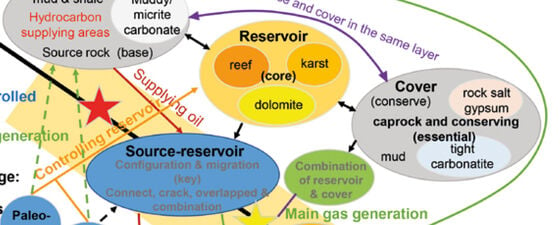The experiences, lessons learned, and best practices of Chinese geoscientists working on difficult hydrocarbon reservoirs can be of benefit to others.
In the quest to produce hydrocarbons from China’s famously deep, harsh and hot reservoirs, Chinese companies, together with research efforts involving key state laboratories and universities, have developed innovative new techniques and technologies, many of which have direct applicability to other basins and reservoirs in the world.
The following examples are just a few of those which were implemented in 2019 and early 2020. The first ones involve research performed at the Chengdu University of Technology, while the final example is the result of findings by Sinopec’s research facilities and operations. The full studies are forthcoming in issues of Sinopec’s Petroleum Drilling Techniques, with abstracts to be available through AAPG’s Search and Discovery website.
Chengdu University of Technology in Sichuan province. © Susan Nash.
Chengdu University of Technology is one of four AAPG-China Research Centers, which were formed to provide a means for scientific exchanges and conferences between geoscientists. These research centers are located at China University of Petroleum-Beijing, Chengdu University of Technology, China University of Petroleum East (Qingdao), and Northeast Petroleum University.
Drilling and Completion for Ultra-Harsh Conditions
Moving outside the lab and looking at drilling and completion operations in the complex environment of the southern Sichuan Basin, engineers and geologists have worked together to develop innovative X-Ray Fluorescence and logging-while-drilling techniques in order to successfully geo-steer wells and to avoid moving out of the target zone. The new tool was successfully applied in 18 wells in the Weirong Gas Field operated by Sinopec.
Slim Liner Cementing Technology
China’s ultra-deep wells, such as those in the Shunbei Block, present serious challenges when it comes to cementing, particularly in the case of a narrow annulus. Some of those challenges include high bottom hole temperature and pressure, weak cement sheaths, high displacement pressure in the downhole pump, and the development of a high-pressure brine layer. To solve the problem, a team at Sinopec developed a new slim liner cementing technology that involved enhanced rheology design and a gas-kill valve that avoided the problems of channeling.
EOR Technologies in China’s Continental Oilfields
The low price of oil and gas does not have the same impact on Chinese oil and gas exploration and production that it might for other countries, primarily due to the fact that the petroleum is destined for domestic consumption, and forms a part of the country’s 5-year and 10-year plans. There is particular emphasis in EOR (enhanced oil recovery) in China’s mature fields because of the existence of excellent infrastructure, such as pipelines, gas conditioning, as well as proximity to markets. As a result, there have been two major thrusts in Sinopec’s research. The first was to develop CO2 injection whenever possible, using carbon captured in coal-fired plants, in order to store it and then inject it into the old fields. Secondly, there has been an emphasis on reducing noise, eliminating methane emissions and on conserving water, particularly in the fields that are technically in urban areas. One promising technique is to use dual parallel simultaneous injection and production, or SIP.
SIP in the Daqing Oilfield
The technique of dual parallel simultaneous injection and production uses a downhole oil–water separation device, which allows the separated water to be injected back into the formation, while the oil with a now much reduced water content is lifted to the surface. In essence, what this gives us is simultaneous injection and production. Used in the Daqing Oilfield operated by PetroChina, initial results included an impressive reduction of water cut from 98% to 77%. Research work is continuing on this technique, with further improvements in sensors and analytics being noted, resulting in improved efficiency and better prediction of equipment failure.
New Technologies for Prospectivity Determination
The exploration process starts by determining the prospectivity of the reservoirs. To that end, new approaches to basin modeling are built by bringing together in-depth geochemical and pore characterization studies. For example, at the Chengdu University of Technology, researchers such as Professor Wen Zhou, Dean of the School of Energy Resources, study the prolific but extremely challenging Sichuan Basin, which contains several petroleum systems, and possesses challenges like carbonate reservoirs, tight gas sand, volcanic reservoirs, shale oil and shale gas, coalbed methane and oil sand. One effective method for determining the age of petroleum generation and then identifying faulting, fracturing, and migration pathways has been to use advanced geochemistry, including isotope fingerprinting, to clarify the dates of five major tectonic movements, before then tracing the 12 separate unconformities.
rofessor Wen Zhou, Dean of the School of Energy Resources at the Chengdu University of Technology.
Because the 13 separate oil and gas reservoirs in the Sichuan Basin primarily produce gas, with the exception of the Jurassic Ziliujing Formation, which also contains oil, the study of gas adsorption along with the reservoir’s geomechanical profile has allowed teams of geologists, geophysicists and engineers to develop 4D models that display how stresses and strains change over time, and the impact of this on the maturation of kerogen, and thus identify the regions of preferential enrichment. In conducting this simulation, it is possible to start building a model that includes recommendations for the location of the laterals. Findings were summarized in the diagram below.
Summary of findings from the prospectivity determination study undertaken at the Chengdu University of Technology. © Zhou, 2020.
Many Successful Innovations
The technologies described in this brief article represent only a few of the innovations designed to successfully tackle the challenging reservoirs in China. While the conditions in most of the world’s reservoirs are not so daunting, the lessons learned can be applied in many places, with better initial success, lower costs and longer-lived production.





